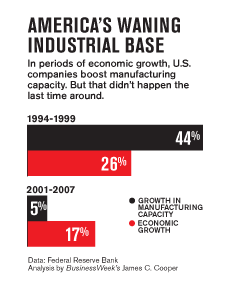The Fantasy of an Export-Led Recovery
Official propaganda has shifted to promoting the notion that America's future growth will come from exports. The idea is pure fantasy. It seems the Obama administration has just fallen in love with the same dream the rest of the world has been pursuing for decades: export your way out of recession. But the dream runs into a number of profound problems, as outlined in this article: For a host of strategic reasons, Bridgelux would like to keep manufacturing in the U.S., but financial realities point to Asia. Not only are taxes far lower and government incentives more generous in such nations as Malaysia, China, and Singapore, but it's easier to raise cheap funding offshore than in the U.S., where private investors frown on manufacturing and bank lending is nearly frozen. CEO Mark Swoboda calls the decision "the toughest challenge facing our company." Take a look at this chart from the article. In a period of non-financial-based prosperity, the late 1990s, then manufacturing growth clearly powered the economy's expansion. As unbelievable as it sounds now, 3COM modems and other gear were manufactured in the midwest in 1997. The "prosperity" of the 2000s was clearly not led by making anything; it was all financial gaming, leverage, and speculation. This chart tells the story: There are several fundamental reasons why an export-led recovery is unfortunately a fantasy. 1. Where does Washington think our foreign customers will get the money to buy manufactured goods from us? The major trading blocs/nations--the EU, Japan, China and Southeast Asia--are all merchantilist economies--they all depend on selling to us (consumers of last resort) to generate their national surplus income. If we slash our purchases of their goods, their economies go into a tailspin and their residents won't have surplus income to buy anyone else's goods--or their own. This is the fundamental flaw in the endlessly repeated canard that "these exporting nations need to encourage their own domestic consumption." Yeah, and how do they do that? By firing all the people making stuff for export to the U.S.? Without exports, their national surplus vanishes and their people lose jobs and income. That is hardly the foundation for "more domestic consumption." The only way we can hope to pursue the same model as all our global competitors is to devalue the dollar to such a degree that U.S.-made goods (priced in other currencies) will be so incredibly cheap that non-U.S. buyers will be compelled to buy U.S. goods by price alone. But if the dollar falls in half, then our imports of all those nations' goods will also collapse, pushing their economies into deep recession. It is indeed a conundrum: if we cut imports then we deprive our potential buyers of the very funds they need to buy our goods. Collapsing the dollar has all sorts of other pernicious side effects, too. What happens to the price of imported oil of the dollar is cut in half? It doubles. What effect will that have on the domestic U.S. economy? Will all the nations pursuing an "export or die" strategy of national economic growth stand by idly while the dollar weakens and their own currencies are driven up to the point that Americans can no longer afford their goods? Of course not; we are already witnessing a "race to tthe bottom" as every nation and trading bloc attempts to lower its currency to keep its flagging export machine running. Even worse from the U.S. point of view, destroying the value of the dollar in an attempt to boost exports fails to take into account that the Chinese peg their renminbi to the dollar. So as the dollar drops, so does the renminbi (yuan). The net result is Chinese goods remain cheap to U.S. consumers regardless of how low the dollar goes. 2. Exports are around 6-7% of the U.S. economy. Even a stupendous 20% increase, as welcome as that would be, would register as a blip in the overall GDP. 3. The supply chain necessary to complex manufacturing has moved overseas. As theBusinessWeek article explains, getting a big fat tax credit for a new factory in the U.S. is only step one: you need a supply chain of components and partners. If that has migrated overseas, then you need to either outsource the overseas components (in which case why assemble anything here?) or re-invent a new supply chain here--an expensive and risky proposition. 4. Though Americans love to give lip service to manufacturing, local government and those living nearby don't like it; thay all want "clean industries" like making movies ($10 billion in a $14 trillion economy--good luck with that) or that wonderful FIRE economy (finance, insurance and real estate) which generates billions of dollars from nice clean office parks and towers. Except when it doesn't. 5. Those touting manufacturing as a "jobs" engine must not have actually toured many factories. To compete globally, any new factory in the U.S. has to be heavily mechanized and automated. A typical factory might have a few dozen employees tending the robots and software. Even a large factory might employ fewer than 200 workers. Pundits who talk about "manufacturing" should spend a day working in an old-fashioned assembly line (if any still exist in the U.S.), putting one part in the same place all day long. It is mind-numbing work and that aspect is always passed over in the bloodless cheerleading by those who have no idea how a semiconductor factory (for instance) actually functions. Even in China, manufacturing is inevitably becoming more automated. That has been "the future" for decades and it remains the future. 6. The cost of doing business in the U.S. is prohibitve and getting more so with each passing day. Healthcare costs rise 6% every year, 25% every four years, regardless of whether Tweedledum or Tweedledee runs Washington or if the economy is growing or shrinking. Every level of government is a sclerotic bureaucracy which makes starting a business a costly, risk-laden challenge. The prevailing attitude is that private enterprise's money "should" flow to government like water flows to the sea, and small business "should" soldier on, paying taxes and making payroll, regardless of how bad the economy gets or how onerous the junk fees and taxes become. As I have long noted, small business (the engine of the economy) has a choice--it can opt out, quit, close its doors. The reasons to do so pile higher every day. Once again, Americans love to pontificate about how much they value small business, even as their governments make doing business a losing proposition. For all these reasons, we should be wary of claims that the U.S. can "grow its way out of recession" on the back of a newly energized manufacturing/export sector and replace the failed "debt-based consumption" model of "growth" with a new one based on exports of manufacturing. It isn't that easy. Expanded free eBook now available (85,300 words, 136 pages): NOTE: the Kindle reader for PCs is now available for free which means you canread the Kindle version of Survival+ on your PC. Thank you, Eileen A. ($5), for your most welcome generous donation to this site. I am greatly honored by your support and readership. Can the Future Be Built in America?(BusinessWeek):
Can the Future Be Built in America?(BusinessWeek):From its headquarters in a modest office park outside Sunnyvale, Calif., Bridgelux is hoping to spark a revolution in light fixtures for homes and offices across the U.S. It's ready to ramp up production of tiny light-emitting chips that blaze as bright as some incandescent bulbs but consume a fraction of the energy. To meet surging orders for its chips, it's prepared to spend $250 million over three years on gleaming cleanrooms. The question is, where should it put its plants?

Permanent link: The Fantasy of an Export-Led Recovery
Get Survival+: Structuring Prosperity for Yourself and the Nation on amazon.com or in ebook and Kindle formats. A 20% discount is available from the publisher.
in HTML: Survival+ in PDF: Survival+
Of Two Minds is now available via Kindle: Of Two Minds blog-Kindle























